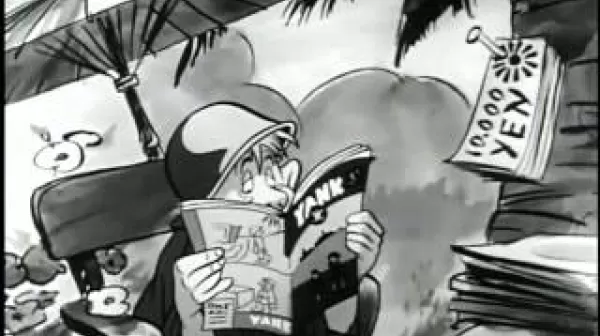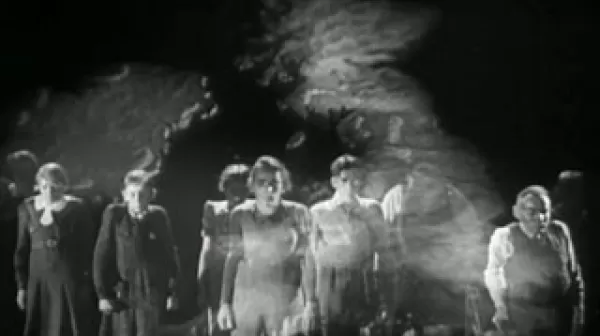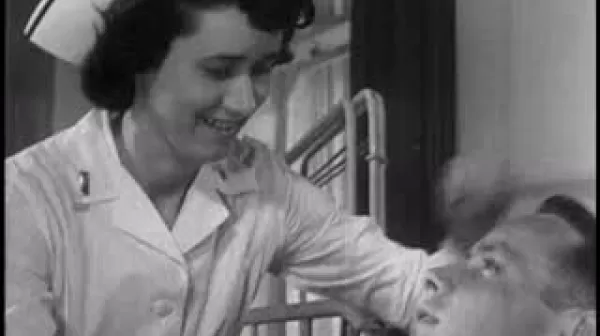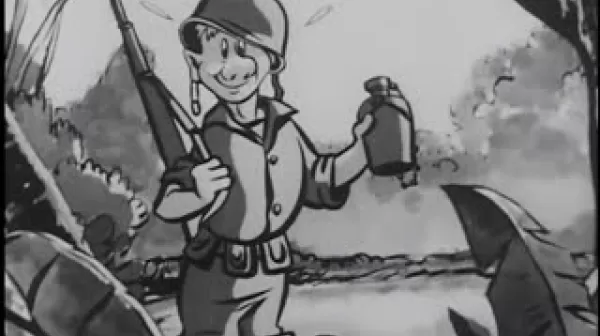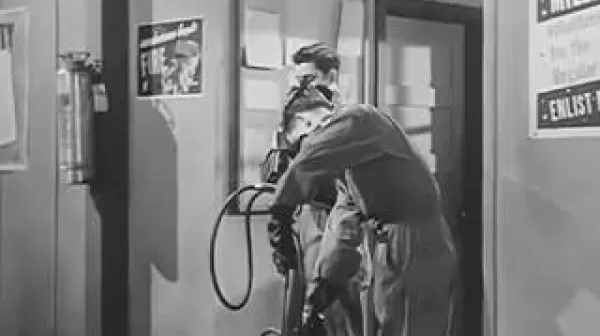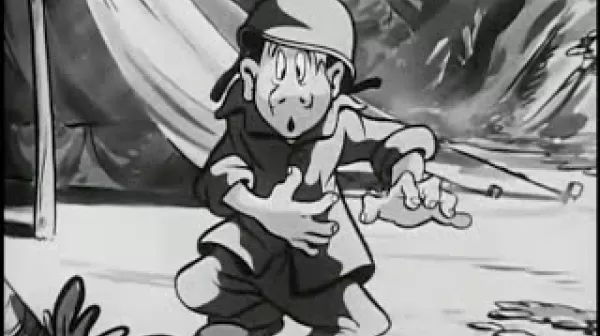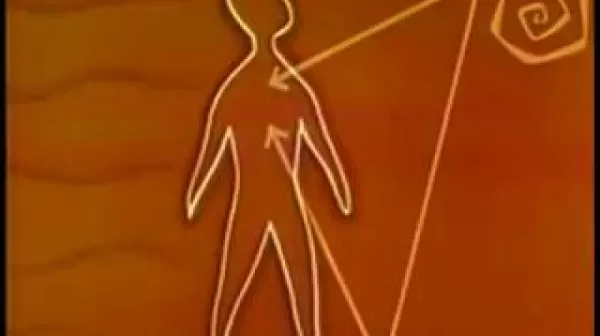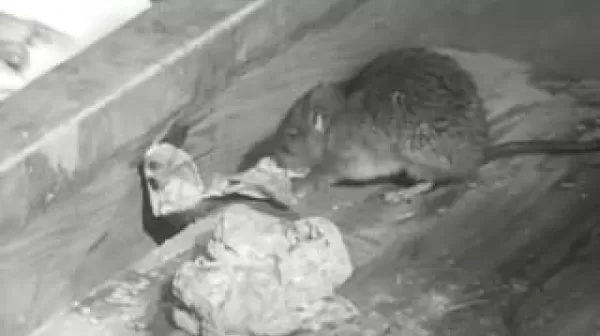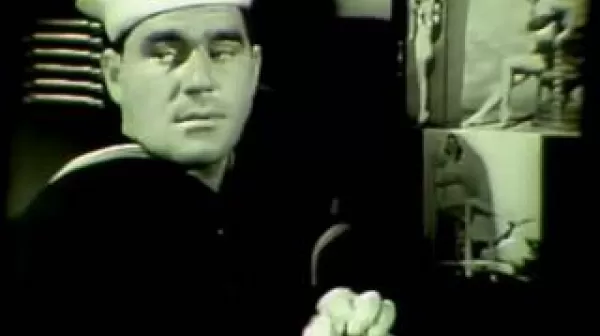Use Your Head (US Navy, 1945)
In animated humorous cartoon, the enlisted man is instructed to use only designated areas for urination and defecation. The dangers of dysentery and fly-borne disease are outlined. The locale is the Asian jungle; the enemy is Japan. Film is aimed at marines in jungle camps. Produced by Hugh Harman Productions for the United States Navy. Learn more about this film and search its transcript at NLM Digital Collections: http://resource.nlm.nih.gov/9419629.
Die englische Krankheit (Third Reich and UFA, 1941)
To toggle captions between German and English, select Settings button to the right of the “CC” symbol (place cursor in the movie frame itself, lower right). In Subtitles/CC box, change preferred language by clicking on the arrow. Captions: Leonhard Link. Made during World War II by the German Ministry of Health in collaboration with UFA, Germany's largest movie studio, this short film combines Nazi propaganda with a discussion of the symptoms, treatment, and prevention of rickets in infants and young children.
The Army Nurse (United States War Office, 1945)
Released in the closing months of the Second World War, this film explores the work of the army nurse in part from the perspective of a wounded soldier. Intended to be shown to a variety of audiences including servicemen, nurses, and potential recruits to nursing, it has a reassuring message about the skill and effectiveness of the army nursing service. It also comforts its audiences with a story about the therapeutic uses of femininity. The film opens with a soldier wounded in action. Coming out of delirium, the first person he sees is a female army nurse, who smiles and winks at him.
Easy to Get (US Army Service Forces, 1947)
In story format, over footage of soldiers picking up girls in a drug store and in a night club, the dangers of sexual intercourse with pick-ups and prostitutes are emphasized. The results of untreated gonorrhea and/or syphilis are shown ina man with swollen knees, a man having a heart attack, an infected penis, a bed-ridden older man, and a man whose speech and memory have become defective. Over and over, the narrator urges the viewer to use condoms, visit the pro station, and report to his medical officer immediately if he suspects that he has contracted a venereal disease.
Drinking Water (US Navy, 1945)
A United States Navy training film In humorous animated cartoon format, the soldier is instructed to drink only water from safe supplies. The consequences of not rationing one's individual water supply when away from camp are shown. The dangers of drinking from untreated water supplies are shown. The locale is the Asian jungle; the enemy is Japan. Film aimed at marines engaged in jungle warfare.
DDT in Control of Household Insects (U.S. War Department, 1947)
This film outlines the control of household insects in military establishments. Flies, roaches, and bedbugs can be controlled by good sanitation and the use of DDT. The equipment and techniques to be used are shown. Identification of presence of pests is discussed. Treatment of barracks, kitchens, and mess halls is shown. NLM Unique ID: 9432127 Learn more about the National Library of Medicine's historical audiovisuals program at: https://www.nlm.nih.gov/hmd/collections/films
Cleaning Mess Gear (US Navy, 1945)
The importance of keeping field mess gear clean and how that should be done properly in the field are presented in humorous cartoon animation. The consequences of using dirty mess gear are shown. The film is aimed at U.S. Marines. The locale is a jungle. Produced by Hugh Harman Productions for the United States Navy.
Survival Stresses (US Air Force, 1961)
Presented as a film within a film, an Air Force officer gives a lecture to a class of fliers about survival skills, using a combination live action-animated film to illustrate the workings of the body and its reactions to difficult situations. Discusses major physiological and psychological stresses that may be encountered in a survival situation in the Arctic, in the desert, in the tropics, and on water. Describes methods of detecting, understanding, and combating such stresses as hunger, thirst, cold, fatigue, and fear. Shows how to recognize and avoid dehydration.
Practical Rat Control: Rat Killing (US Army, 1950)
This film details several methods of killing domestic rats, including various types of poison mixed into foods rats like, cleaning and repairing premises to discourage rat habitation, metal traps, and the elimination of rat harborages. Learn more about this film and search its transcript at NLM Digital Collections: http://resource.nlm.nih.gov/9423674.
For Which We Stand (United States Navy, 1950)
In this film, servicemen are strongly urged to forgo illicit and casual sex because it is degrading and contrary to divine will. The joys of marriage and family are stressed. Long-term happiness should be the goal, not immediate gratification. A medical officer discusses sexual abstinence, saying that it will not adversely affect a man's virility. A commanding officer points out that sexual promiscuity among troops is not just the concern of the medical officer and the chaplain. He says that self-control should be practiced by everyone.
Introduction to Combat Fatigue (US Navy, 1944)
This formerly restricted film was intended to be shown to patients suffering from combat fatigue. A medical officer/narrator explains the nature of fear and how it helps the body and mind cope with threatening situations. Profiling a soldier named Edwards, the narrator explains how combat fatigue begins, grows, and finally incapacitates the soldier. Aboard a ship headed for the combat zone, Edwards feels excitement and tension. In the combat zone, he behaves as expected -- he leaves his ship, wades ashore, penetrates a jungle area, and fires at the enemy. He is afraid but not cowardly.

